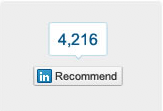 In late 2009, LinkedIn opened up its API to allow select developers make applications that tap into LinkedIn’s social network. The professional social network released nearly a dozen APIs which gave third-party developers the ability to access user profile information, message LinkedIn contacts, search LinkedIn and more. Over 1,000 developers tested the platform, which has served one billion page views since November 2009. Today, LinkedIn is opening up access to the network’s new platform to all developers. The network is releasing support for OAuth 2.0 and Javascript APIs, as well as access to LinkedIn’s new customizable Plugins, which are features that can be customized and embedded on websites with minimal effort.
In late 2009, LinkedIn opened up its API to allow select developers make applications that tap into LinkedIn’s social network. The professional social network released nearly a dozen APIs which gave third-party developers the ability to access user profile information, message LinkedIn contacts, search LinkedIn and more. Over 1,000 developers tested the platform, which has served one billion page views since November 2009. Today, LinkedIn is opening up access to the network’s new platform to all developers. The network is releasing support for OAuth 2.0 and Javascript APIs, as well as access to LinkedIn’s new customizable Plugins, which are features that can be customized and embedded on websites with minimal effort.
The idea behind plugins is to give developers are more lightweight way to embed LinkedIn functionality and data on third-party sites. ALl of the plugins can be integrated onto websites with just a few lines of javascript and are customizable, says LinkedIn engineer Adam Nash. For example, LinkedIn’s Member Profile plugins brings a snippet of user profiles to a third-party site and can show users who they know within an application in a professional context. Company Profile plugin delivers at-a-glance summaries of companies on LinkedIn’s network, including location, number of employees and more.
 And the Company Insider plugin displays in-depth, personalized insights from LinkedIn about companies featured on a site. For example, you can access a summary of who in a visitors’ network works at a given company, a list of new hires, and job changes. Developers can also embed the ability to follow a company within their sites.
And the Company Insider plugin displays in-depth, personalized insights from LinkedIn about companies featured on a site. For example, you can access a summary of who in a visitors’ network works at a given company, a list of new hires, and job changes. Developers can also embed the ability to follow a company within their sites.
Other plugins include a recommend button, which allows users to promote a product on LinkedIn from a third-party site with a link back to the site. And LinkedIn also allows developers to embed a LinkedIn Share button on sites, which is similar to Twitter’s Tweet button and can feature share counts and more.
LinkedIn has also made a number of “infrastructure improvements” to the developer platform. For example, the JavaScript framework loads significantly faster, and the company has added SSL support and
more robust OAuth support. Additionally, LinkedIn has redesigned its Platform and API portal to make it easier for developers to access content and deploy plugins.
LinkedIn just crossed the 100 million member mark, and in order to continue to drive member and visitor growth the network is going to have to present developers with innovative ways to embed LinkedIn functionality on outside sites. Facebook and Twitter have both done this at a massive scale. Launching lightweight plugins that are easy for developers to embed is probably a wise way to spread LinkedIn across the web.































Comment